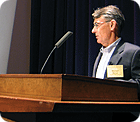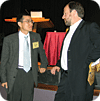Many of the 225 papers presented focused on R&D taking place in research facilities around the world. And a series of plenary addresses that opened each day of sessions also looked to the future - in one case, all the way to 2050. In all, some 500 attendees from 30 countries took part in the four-day event that takes place every other year.

ENERGY SOURCES
The plenary sessions noted ongoing efforts at making HVACR equipment more energy efficient. But even more attention was paid to ways to create enough power to run the equipment. For, as noted by Michael Moran of the Department of Mechanical Engineering at Ohio State University, by the year 2050, the world population - which today is 6.5 billion - will be 9.4 billion, creating an even greater demand for the most energy-efficient equipment.For Moran, the search for additional energy sources has to go beyond oil, "our Achilles heel." While proved and probable reserves from known fields may yield in excess of 850 billion barrels, he said annual usage is now 30 billion barrels and that is expected to rise to 38 billion by 2015. "Do the math," he said, noting supplies may last anywhere from 26 to 33 years.
Natural gas is another consideration, he said, but "U.S. gas production peaked in the 70s and has declined ever since."
Thus the need for more conservation and finding additional sources, he said. Cellulosic ethanol is being talked about, he said, but depends "on the ability to produce ethanol from low-cost biomass as key to making it competitive as a fuel."

The nuclear option concerns are waste storage and plant security issues, but "currently there is a lot of activity in business and government aimed at jump-starting nuclear power in the United States using fission reactors."
A common power-generating source today is coal. But while the coal industry says "it has coal reserves to last hundreds of years," Moran warned that "much of the best quality, easy-to-get coal has been mined" and future efforts may require open-pit mines and mountaintop removal that raises environmental issues.
Technology may help deal with those issues, he said, such as using coal and natural gas as feedstock for the Fischer-Tropsch process that is a chemical reaction for producing synthetic fuels. He also noted a "government project aimed at building a nearly zero-emission coal-fired plant that co-generates electricity and hydrogen."
The need for better conservation comes from the perspective that the United States per capita domestic water use, energy use, and CO2 emissions rank well above those of such countries as Denmark, Japan, Germany, France, the United Kingdom, and Italy.
Werner Soedel, professor of mechanical engineering at Purdue, also touched on the energy issue during a Q&A session at the conclusion of a talk he gave on his long involvement with compressor technology.
"Global warming - which appears to be true - will increase the demand for refrigeration and air conditioning. But where will the power generation come from?"
He suggested more attention needs to be given to atomic energy.
At the same time, efforts at making better and more energy-efficient equipment was stressed in a talk by Samchul Ha, director and vice president of LG Electronics' Digital Appliance Labs.
High-efficiency HVAC systems are becoming part of a mix that also includes "intelligent solutions and intelligent IAQ for energy savings, ease of management, health, and productivity."
He said the industry is capable of finding "eco-friendly refrigerants and new energy sources." He applauded the use of energy efficiency rating systems throughout the world and cited such new directions in equipment as plasma treated aluminum heat exchangers, mechanical capacity modulation compressors, and electrical modulation compressor motors.
Publication date: 09/04/2006


Report Abusive Comment